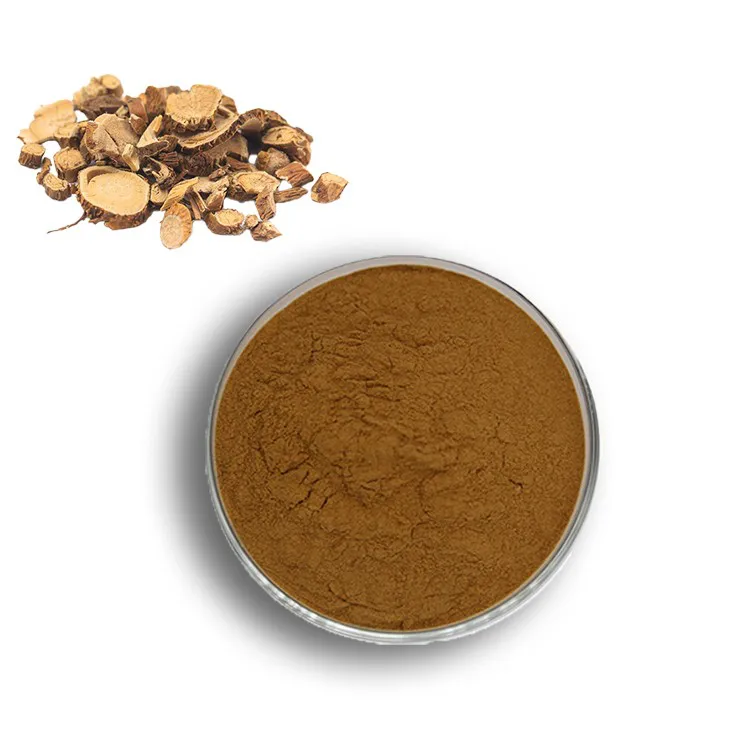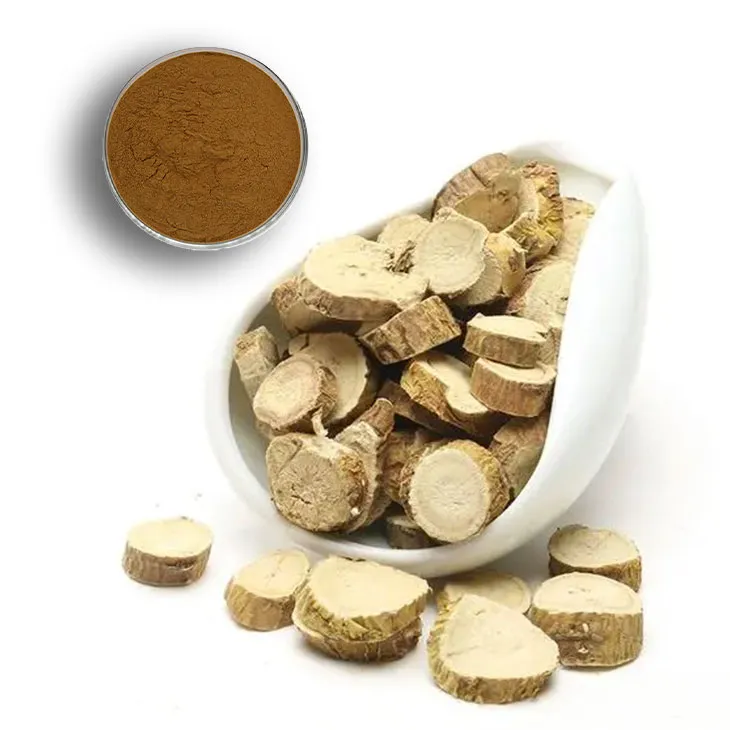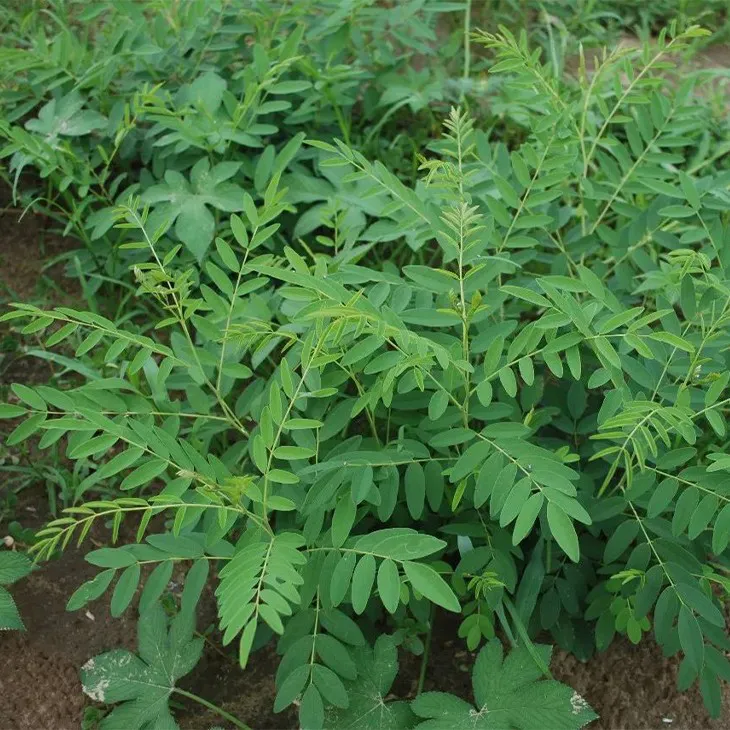- 0086-571-85302990
- sales@greenskybio.com
Components of fertilizer and feed from Sophora flavescens root extract.
2024-11-30

1. Introduction
Sophora flavescens, also known as Kushen, has a long history of use in traditional medicine in many Asian countries. In recent years, its root extract has been increasingly studied for its potential applications in fertilizers and feeds. This is due to the fact that the extract is rich in various bioactive components that can bring many benefits to plants and livestock.

2. Components of Sophora Flavescens Root Extract as a fertilizer
2.1 Nutrients
Sophora Flavescens Root Extract contains a certain amount of nutrients that are essential for plant growth. These include nitrogen, phosphorus, and potassium. Although the content may not be as high as in some traditional chemical fertilizers, these nutrients are in an organic form, which can be more easily absorbed by plants. For example, nitrogen in the extract can be converted into amino acids, which are the building blocks of proteins in plants. Phosphorus is important for energy transfer and cell division in plants, and potassium helps in regulating water balance and enhancing plant resistance.
2.2 Growth - promoting substances
One of the most important aspects of Sophora Flavescens Root Extract as a fertilizer is the presence of growth - promoting substances. These substances can stimulate plant growth in multiple ways.
- Plant hormones: The extract may contain plant hormones such as auxins, cytokinins, or gibberellins in small amounts. Auxins are known for promoting root growth and cell elongation. Cytokinins can stimulate cell division, which is crucial for plant growth and development. Gibberellins can enhance stem elongation and seed germination.
- Amino acids: Amino acids in the extract can also act as growth - promoting agents. They can be directly absorbed by plants and used for protein synthesis. Some amino acids, like glutamic acid, can also improve the efficiency of nutrient absorption in plants.
- Organic acids: Organic acids present in the extract, such as citric acid and malic acid, can improve soil structure. They can chelate metal ions in the soil, making them more available for plant uptake. At the same time, they can also adjust the soil pH, creating a more favorable environment for plant growth.
2.3 Disease - and pest - resistant components
Sophora flavescens root extract contains certain components that can enhance plant resistance to diseases and pests.
- Alkaloids: Alkaloids are one of the main bioactive components in Sophora flavescens. Some alkaloids have been shown to have antifungal and antibacterial properties. For example, matrine and oxymatrine can inhibit the growth of certain plant - pathogenic fungi and bacteria, reducing the incidence of diseases in plants.
- Flavonoids: Flavonoids are also present in the extract. They can act as antioxidants, protecting plants from oxidative stress caused by diseases and pests. In addition, some flavonoids can induce plant defense mechanisms, such as the production of phytoalexins, which are antimicrobial compounds produced by plants in response to pathogen attack.

3. Components of Sophora flavescens root extract as a feed
3.1 Nutritional components
In terms of feed, Sophora flavescens root extract can provide some nutritional components for livestock.
- Protein - related components: Although the extract may not be a major source of protein, it may contain amino acids and peptides that can supplement the protein requirements of livestock. These components can be used for muscle growth and repair in animals.
- Minerals: The extract may also contain certain minerals such as calcium, phosphorus, and iron. These minerals are essential for bone development, blood formation, and other physiological functions in livestock.
3.2 Bioactive components for health improvement
The bioactive components in Sophora flavescens root extract can have a positive impact on the health of livestock.
- Antimicrobial components: Similar to its role in plants, the alkaloids and flavonoids in the extract can have antimicrobial effects in livestock. They can help prevent and treat infections in animals, reducing the need for antibiotics. For example, in poultry farming, the use of Sophora flavescens root extract in feed may help control Salmonella infections.
- Immune - enhancing components: Some components in the extract can stimulate the immune system of livestock. This can lead to better resistance to diseases and a reduction in mortality rates. For example, polysaccharides in the extract may activate immune cells in animals, enhancing their immune function.
- Digestive - promoting components: The extract may also contain components that can improve the digestive function of livestock. For example, certain organic acids in the extract can stimulate the secretion of digestive enzymes in the gut, improving the digestion and absorption of nutrients.
3.3 Growth - promoting components for livestock
There are several components in Sophora flavescens root extract that can promote the growth of livestock.
- Hormone - like components: Some substances in the extract may have hormone - like effects. They can regulate the metabolism of livestock, promoting the growth of muscle and fat tissues. For example, they may affect the secretion of growth hormones in animals, leading to increased growth rates.
- Amino acids and peptides: As mentioned before, these components can be used for protein synthesis in animals, which is directly related to growth. In addition, they can also improve the quality of meat, milk, or eggs produced by livestock.

4. Extraction and purification methods
To obtain the components of Sophora flavescens root extract for use in fertilizers and feeds, appropriate extraction and purification methods are required.
- Solvent extraction: One of the most common methods is solvent extraction. Ethanol, methanol, or water can be used as solvents. Ethanol is often preferred because it can extract a wide range of components and is relatively safe. The root of Sophora flavescens is crushed and soaked in the solvent, and then the extract is obtained through filtration and evaporation of the solvent.
- Supercritical fluid extraction: Supercritical fluid extraction, especially using carbon dioxide, is also a promising method. It can extract components with high purity and without leaving harmful residues. However, this method requires more expensive equipment and strict operating conditions.
- Purification: After extraction, purification steps are often necessary to remove impurities and obtain the desired components. Chromatography techniques such as high - performance liquid chromatography (HPLC) can be used for purification. This can separate different components based on their chemical properties, such as polarity and molecular weight.
5. Safety and regulatory aspects
When using Sophora flavescens root extract in fertilizers and feeds, safety and regulatory aspects need to be considered.
- Safety for plants and livestock: Although the extract has many beneficial components, excessive use may also have negative impacts. For example, high concentrations of alkaloids may be toxic to plants or livestock. Therefore, appropriate dosages need to be determined through scientific research.
- Regulatory requirements: In different countries and regions, there are regulatory requirements for the use of plant extracts in fertilizers and feeds. These regulations are mainly to ensure the safety and quality of agricultural products. For example, in some areas, the use of Sophora flavescens root extract in feed may require approval from relevant regulatory agencies, and strict quality control standards need to be followed.
6. Conclusion
Sophora flavescens root extract has great potential as a component in fertilizers and feeds. It contains a variety of nutrients, growth - promoting substances, disease - and pest - resistant components in the case of fertilizers, and nutritional, bioactive, and growth - promoting components in the case of feeds. However, further research is still needed to optimize extraction methods, determine appropriate dosages, and meet regulatory requirements. With continuous research and development, Sophora flavescens root extract is expected to play an increasingly important role in modern agriculture and livestock farming.
FAQ:
What are the main growth - promoting substances in Sophora flavescens root extract for plants?
The main growth - promoting substances in Sophora flavescens root extract may include various alkaloids and flavonoids. These substances can influence plant physiological processes such as cell division and elongation, which in turn enhance plant growth. For example, some alkaloids may act as natural stimulants for root development, enabling plants to better absorb water and nutrients from the soil.
How does Sophora flavescens root extract improve plant resistance to diseases and pests?
The extract may contain bioactive compounds that can trigger the plant's natural defense mechanisms. Some components in the extract might be involved in the production of phytoalexins, which are antimicrobial compounds that plants synthesize in response to pathogen attacks. Additionally, it could enhance the physical barriers of plants, like thickening the cell walls, making it more difficult for pests to penetrate and for diseases to infect the plants.
What bioactive components in Sophora flavescens root extract are beneficial for livestock in feed?
There may be components such as saponins and certain polysaccharides. Saponins can have positive effects on the digestive system of livestock, for example, by improving nutrient absorption. Polysaccharides might enhance the immune function of livestock, helping them to better resist diseases. Moreover, some unique alkaloids in the extract could potentially have anabolic effects, promoting the growth and development of livestock.
Are there any potential negative effects of using Sophora flavescens root extract in fertilizers and feeds?
Although Sophora flavescens root extract has many potential benefits, improper use may lead to some problems. For example, if the concentration of certain active substances in the extract is too high in fertilizers, it may cause phytotoxicity to plants. In feeds, excessive amounts of some components may disrupt the normal physiological functions of livestock. Therefore, it is crucial to determine the appropriate dosage and application methods to avoid potential negative impacts.
How can the components of Sophora flavescens root extract be effectively extracted for use in fertilizers and feeds?
Common extraction methods include solvent extraction, for example, using ethanol or water - ethanol mixtures. Ultrasonic - assisted extraction can also be employed to increase the extraction efficiency. After extraction, purification steps may be necessary to remove impurities and obtain the components in a more concentrated and pure form. The extracted components can then be formulated into fertilizers or feeds according to the required dosage and specifications.
Related literature
- Title: Study on the Active Components of Sophora flavescens Root Extract and Their Applications in Agriculture"
- Title: "Beneficial Effects of Sophora flavescens Root Extract in Livestock Feed: A Review"
- Title: "The Role of Sophora flavescens Root Extract in Enhancing Plant Resistance: Chemical Components and Mechanisms"
- ▶ Hesperidin
- ▶ citrus bioflavonoids
- ▶ plant extract
- ▶ lycopene
- ▶ Diosmin
- ▶ Grape seed extract
- ▶ Sea buckthorn Juice Powder
- ▶ Beetroot powder
- ▶ Hops Extract
- ▶ Artichoke Extract
- ▶ Reishi mushroom extract
- ▶ Astaxanthin
- ▶ Green Tea Extract
- ▶ Curcumin Extract
- ▶ Horse Chestnut Extract
- ▶ Other Problems
- ▶ Boswellia Serrata Extract
- ▶ Resveratrol Extract
- ▶ Marigold Extract
- ▶ Grape Leaf Extract
- ▶ blog3
- ▶ blog4
-
The Most Highly - Praised Seabuckthorn Oil.
2024-11-30
-
Wholesale Acai Berry Extract Suppliers.
2024-11-30
-
The best artichoke leaf extract from nature.
2024-11-30
-
Optimal Bioavailability of Green Tea Extract
2024-11-30
-
The best lemon extract on the market.
2024-11-30
-
Maca Extract
2024-11-30
-
Uridine-5'-monophosphate Disodium salt
2024-11-30
-
Cassia Seed Extract
2024-11-30
-
Longan Extract
2024-11-30
-
Resveratrol extract
2024-11-30
-
Phyllanthus Emblica Extract
2024-11-30
-
Rosemary extract
2024-11-30
-
Buckthorn bark extract
2024-11-30
-
Hedyotis Diffusa Extract
2024-11-30
-
Yellow Pine Extract
2024-11-30





















